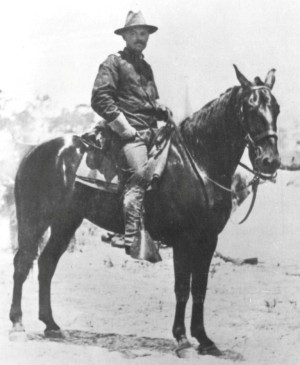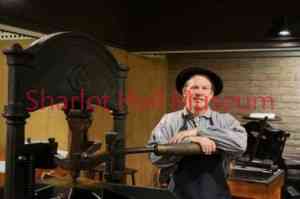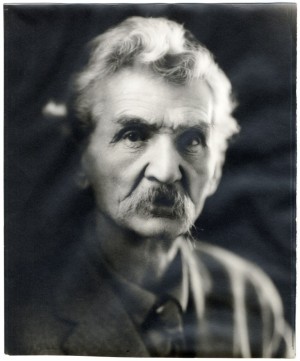By Troy Groves
 James Henry McClintock was himself a remarkable individual in Arizona history. He was a teacher, civil servant, journalist, cavalry officer in the Rough Riders, and author, so it was with no little insight that he penned the following in his 1916 work on Arizona history:
James Henry McClintock was himself a remarkable individual in Arizona history. He was a teacher, civil servant, journalist, cavalry officer in the Rough Riders, and author, so it was with no little insight that he penned the following in his 1916 work on Arizona history:
Outside of a sort of psychic fascination, there appears to have been no possible reason for the way in which men have plunged into the deserts and mountains of Arizona to establish newspapers. Yet there has been pride in many an Arizona hamlet, with its people gathered around the little hand press, to welcome the birth of a journalistic babe of promise that should carry afar the story of their greatness and of their hopes. Damp and limp the first copy came off the press, and with its appearance the camp forthwith stepped full panoplied into metropolitan magnitude. The editor would not have changed jobs with Horace Greeley. (1916 McClintock’s Arizona, prehistoric, aboriginal, pioneer, modern: The nation's youngest commonwealth within land of ancient culture.)
 The early history of Arizona cannot be told without acknowledging the newspaper owners, publishers, editors, compositors and pressmen who were present from the earliest beginnings. The wood and iron presses they dragged into the wilderness and kept in operation under the most difficult of circumstances were crucial to developing civilization in the wilderness. The papers and publications they printed kept the local citizens informed and, perhaps more importantly, let the outside world know what was happening in the wilderness that was then Arizona. To a great extent, most of the stories we know about Arizona history today were first printed on newsprint using hand set type when that history was still news.
The early history of Arizona cannot be told without acknowledging the newspaper owners, publishers, editors, compositors and pressmen who were present from the earliest beginnings. The wood and iron presses they dragged into the wilderness and kept in operation under the most difficult of circumstances were crucial to developing civilization in the wilderness. The papers and publications they printed kept the local citizens informed and, perhaps more importantly, let the outside world know what was happening in the wilderness that was then Arizona. To a great extent, most of the stories we know about Arizona history today were first printed on newsprint using hand set type when that history was still news.
The beginnings of Arizona printing started with an iron hand press brought overland across Texas and New Mexico into Tubac by William Wrightson, an official of the Santa Rita Silver Mining Company, former editor of the Railroad Record in Cincinnati, and owner operator of a book and job printing office in Ohio. Once in Arizona, he teamed up with Edward E. Cross, former editor of The Cincinnati Times and an itinerant printer and correspondent. Together they published The Arizonian in 1859. Cross gained notoriety as one of the participants in the famous Tubac bloodless duel using Burnside rifles in 1859. Apaches killed Wrightson near Fort Buchanan in 1861. The printing press they used was taken to Tucson, seized and used by the California Volunteers during the Civil War, and used to print the Tucson Arizona Star, the Tombstone Nugget and Tombstone Epitaph. It was donated to the Arizona Historical Society in Tucson in 1933 and currently can be seen in the museum at the Tubac Presidio.
 Before becoming Arizona’s first Territorial Secretary, Richard McCormick had been editor of Young Men’s Magazine and the New York Evening Post, as well as a war correspondent in Europe during the Crimean war of 1853 -1856. In Arizona, he teamed up with Tisdale Hand, an enigmatic printer from New York, and Albert Banta, an itinerant printer and editor turned bullwhacker from Missouri. Together they not only started the Prescott Miner, but they also published several booklets and did job printing for the newly formed territorial government. McCormick went on to become Governor and owned The Miner until selling it to one of Arizona’s more notorious newspapermen, John Marion, in 1867. Hand had a near fatal confrontation with drifter gunman Lou Thrift in a Prescott saloon before leaving the territory. Banta set his hand to many varied enterprises in the territory, including starting a journal called the Prescott Prospect in 1899.
Before becoming Arizona’s first Territorial Secretary, Richard McCormick had been editor of Young Men’s Magazine and the New York Evening Post, as well as a war correspondent in Europe during the Crimean war of 1853 -1856. In Arizona, he teamed up with Tisdale Hand, an enigmatic printer from New York, and Albert Banta, an itinerant printer and editor turned bullwhacker from Missouri. Together they not only started the Prescott Miner, but they also published several booklets and did job printing for the newly formed territorial government. McCormick went on to become Governor and owned The Miner until selling it to one of Arizona’s more notorious newspapermen, John Marion, in 1867. Hand had a near fatal confrontation with drifter gunman Lou Thrift in a Prescott saloon before leaving the territory. Banta set his hand to many varied enterprises in the territory, including starting a journal called the Prescott Prospect in 1899.
 Their old Ramage press continued to serve into the 1880s, and was still present in the Miner when that printing office, along with the printing offices of the Prescott Courier, the Prescott Prospect, and numerous other Prescott businesses were swallowed by the flames and dynamiting during the great Prescott fire of 1900. The stone bed of the press (the flat stone used for composing the layout of hand set type) was reputed to have still been in use as an “imposing stone” well into the 20th century.
Their old Ramage press continued to serve into the 1880s, and was still present in the Miner when that printing office, along with the printing offices of the Prescott Courier, the Prescott Prospect, and numerous other Prescott businesses were swallowed by the flames and dynamiting during the great Prescott fire of 1900. The stone bed of the press (the flat stone used for composing the layout of hand set type) was reputed to have still been in use as an “imposing stone” well into the 20th century.
These are a few brief highlights to awaken curiosity about the newspapermen of Arizona Territory, industrious men of learning, vision and iron who not only chronicled the stories but lived them as well.
Sharlot Hall Museum will be hosting a free lecture on “Pressmen of Frontier Arizona: Bringing Civilization to the Wilderness” by Troy Groves on Saturday, November 10, 2018 at 2 p.m. in the West Gallery of Sharlot Hall Museum’s Lawler Exhibit Center.
“Days Past” is a collaborative project of the Sharlot Hall Museum and the Prescott Corral of Westerners International (www.prescottcorral.org). This and other Days Past articles are also available at https://sharlothallmuseum.org/articles/days-past-articles.l. The public is encouraged to submit proposed articles and inquiries to dayspast@sharlothallmuseum.org. Please contact SHM Library & Archives reference desk at 928-445-3122 Ext. 2, or via email at archivesrequest@sharlothallmuseum.org for information or assistance with photo requests.


